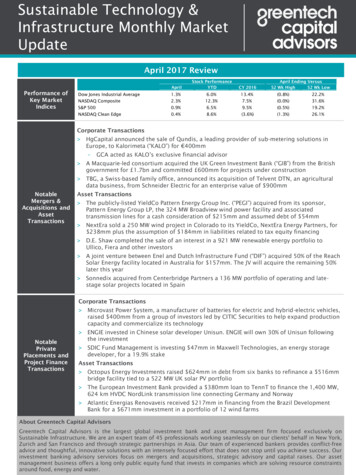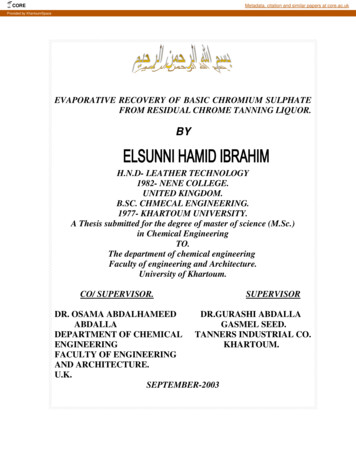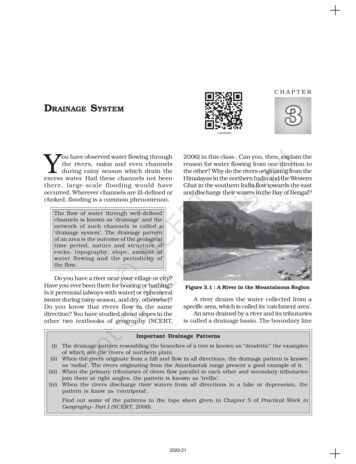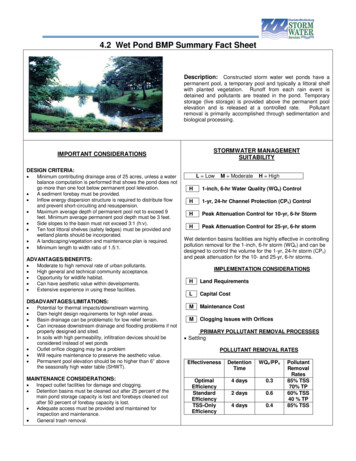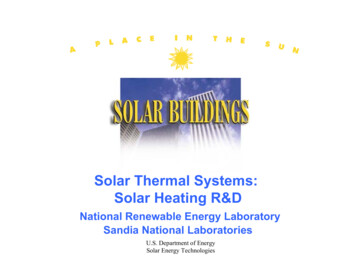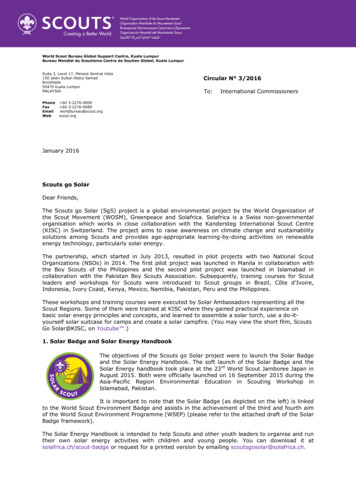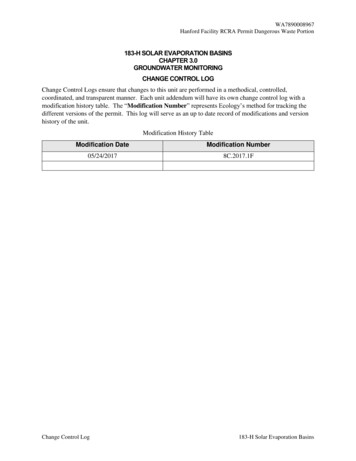
Transcription
WA7890008967Hanford Facility RCRA Permit Dangerous Waste Portion183-H SOLAR EVAPORATION BASINSCHAPTER 3.0GROUNDWATER MONITORINGCHANGE CONTROL LOGChange Control Logs ensure that changes to this unit are performed in a methodical, controlled,coordinated, and transparent manner. Each unit addendum will have its own change control log with amodification history table. The “Modification Number” represents Ecology’s method for tracking thedifferent versions of the permit. This log will serve as an up to date record of modifications and versionhistory of the unit.Modification History TableModification DateModification Number05/24/20178C.2017.1FChange Control Log183-H Solar Evaporation Basins
WA7890008967Hanford Facility RCRA Permit Dangerous Waste PortionThis page intentionally left blank.Change Control Log183-H Solar Evaporation Basins
WA7890008967183-H Solar Evaporation Basins1234CHAPTER 3.0GROUNDWATER MONITORINGChapter 3.i
WA7890008967183-H Solar Evaporation Basins12345This page intentionally left blank.Chapter 3.ii
WA7890008967183-H Solar Evaporation Basins1EXECUTIVE SUMMARY23456789101112131415This document presents a revision to the 1997 183-H Solar Evaporation Basins groundwater monitoringplan.1 This revised monitoring plan is based on the requirements for final status facilities, as identified inthe WA7890008967, Hanford Facility Resource Conservation and Recovery Act (RCRA) Permit,Dangerous Waste Portion for the Treatment, Storage, and Disposal of Dangerous Waste2 (hereafterreferred to as the Hanford Facility RCRA Permit), Part II, Condition II.F, which specifies that final statusgroundwater monitoring programs are subject to the requirements in WAC 173-303-645.3 Due to the ageof the plan, the United States Department of Energy, Richland Operations Office is revising thisgroundwater monitoring plan to ensure that the plan contains the most current Hanford Site groundwatermonitoring information for the post-closure unit group (e.g., changes in the constituents to be monitored,sampling frequency, well network, concentration limits, statistical evaluation, identification of point ofcompliance wells, and clarification of compliance period). This document will supersede the previousgroundwater monitoring plan (PNNL-11573) upon modification of the Hanford Facility RCRA Permit.This corrective action groundwater monitoring plan is the principal controlling document for conductinggroundwater monitoring at 183-H Solar Evaporation Basins.16171819202122232425The 183-H Solar Evaporation Basins are a final status, post-closure unit group (Post Closure UnitGroup 2) in the 100-HR-1 Source Operable Unit (OU). The 183-H Solar Evaporation Basins are locatednorth of the 105-H Reactor. The 183-H Solar Evaporation Basins are in modified closure with correctiveaction. The four basins were originally part of the 183-H water treatment facility but were used forevaporation of 300 Area fuel fabrication wastes from 1973 to 1985. In 1996, the basins were demolishedand the soil was removed to a depth of 0.6 m (2 ft) below the basin floor, with excavation to 4.6 m (15 ft)below Basin 1. The basin floor depth ranged from 4.7 to 5.0 m (15.5 to 16.5 ft). Groundwater protectionwas demonstrated through modeling and a modified closure (soil column) was approved in 1997. Cleanclosure was not approved due to high levels of fluoride and nitrate remaining in the soil 4.6 m (15 ft)below the Basin 1 floor. Groundwater at the site is approximately 13 m (42 ft) below ground surface.262728293031A final status groundwater compliance monitoring program in accordance with WAC 173-303-645 wasimplemented in 1995 (WHC-SD-EN-AP-1804). The plan identified chromium (collected as a filteredsample) and nitrate as dangerous waste constituents and technetium-99 and uranium as waste indicators.Fluoride was monitored as an indicator of 183-H contamination in groundwater. Additional constituentsto aid data interpretation (alkalinity, anions, and selected metals) and field parameters (pH, specificconductance, temperature, and turbidity) were also included.32333435The first samples collected under the compliance monitoring plan exceeded concentration limits fornitrate, chromium, uranium, and technetium-99. As a result, corrective action was required.Groundwater remediation (pump and treat) was undertaken as part of the interim remedial measure (IRM)and, therefore, the corrective action for the 183-H Solar Evaporation Basins was deferred to the1PNNL-11573, 1997, Groundwater Monitoring Plan for the 183-H Solar Evaporation Basins, Pacific NorthwestNational Laboratory, Richland, Washington. Available accession D1659822.2WA7890008967, Hanford Facility Resource Conservation and Recovery Act (RCRA) Permit, Dangerous WastePortion for the Treatment, Storage, and Disposal of Dangerous Waste, Revision 8c, as amended, Washington StateDepartment of Ecology, Richland, Washington. Available dwp/rev/8c/index.html.3WAC 173-303-645, “Releases from Regulated Units,” Washington Administrative Code, Olympia, Washington.Available at: http://app.leg.wa.gov/WAC/default.aspx?cite 173-303-645.4WHC-SD-EN-AP-180, 1995, Groundwater Monitoring Plan for the 183-H Solar Evaporation Basins, Rev. 0,Westinghouse Hanford Company, Richland, Washington. Available accession D196050052.Chapter 3.iii
WA7890008967183-H Solar Evaporation Basins1234Comprehensive Environmental Response, Compensation, and Liability Act of 1980 (CERCLA)5 program(Soper, 19976). The IRM commenced in 1997 and is ongoing at the 100-HR-3 groundwater OU. Inaccordance with WAC 173-303-645(11), a final status, corrective action groundwater monitoring plan(PNNL-11573) replaced the compliance monitoring plan (WHC-SD-EN-AP-180) in 1997.5678910111213This revised groundwater monitoring plan retains total chromium, collected as a filtered sample, andnitrate as dangerous waste constituents identified for corrective action monitoring. Other constituentsidentified for monitoring in the previous plan (PNNL-11573), uranium, technetium-99, and fluoride, areremoved in this revised plan. Fluoride is no longer monitored because it is below background and hasbeen below its background groundwater concentration in the monitoring well network throughout thecorrective action monitoring period. Monitoring of uranium is conducted under the CERCLA remedialaction. Technetium-99 is monitored under the Atomic Energy Act of 19547 groundwater monitoringprogram. Alkalinity, anions, and metals are also not included in this plan since these analytes arecollected at multiple nearby wells supporting the IRM.14151617181920This revised groundwater monitoring plan presents an updated corrective action monitoring plan of theuppermost aquifer beneath the 183-H Solar Evaporation Basins. This plan addresses the following: Number, locations, and depths of wells in the 183-H Solar Evaporation Basins groundwatermonitoring network. Sampling and analytical methods of dangerous waste required under corrective action monitoring. Methods for evaluating groundwater quality information. Schedule for groundwater monitoring at the 183-H Solar Evaporation Basins.2122232425This revised plan modifies the existing groundwater monitoring well network as identified in the previousgroundwater monitoring plan (PNNL-11573). Previous monitoring network changes occurred in 2005and 2013 and were incorporated into the Hanford Facility RCRA Permit. In 2005, well 199-H4-7 wasremoved from the monitoring network and replaced with 199-H4-8. In 2013, well 199-H4-84 replaced199-H-3 when it was decommissioned.262728293031This plan removes well 199-H4-12C, which is completed in the confined aquifer, from the monitoringnetwork. Monitoring well 199-H4-12A is replaced with 199-H4-85, which is located closer to the 183-HSolar Evaporation Basins and is completed in the unconfined aquifer. New wells 199-H4-88 and199-H4-89 were drilled in 2016 and are added to the monitoring network. In summary, upon HanfordFacility RCRA Permit modification, the well network will include wells 199-H4-8, 199-H4-84, 199-H485, 199-H4-88, and 199-H4-89. The monitoring network wells represent the point of compliance.3233Groundwater flows generally toward the east-northeast beneath the 183-H Solar Evaporation Basins and isinfluenced by the ongoing IRM as well as changes in river stage.343536The concentration limit for total chromium (filtered) in this plan is changed to 48 µg/L.This concentration represents the WAC 173-340-720(3)8, “Model Toxics Control Act-Cleanup,”“Groundwater Cleanup Standards,” “Method B Cleanup Levels for Potable Groundwater,” groundwater5Comprehensive Environmental Response, Compensation, and Liability Act of 1980, 42 USC 9601, et seq.,Pub. L. 107-377, December 31, 2002. Available at: http://epw.senate.gov/cercla.pdf.6 Soper, W.W., 1997, “Re: Acceptance of “Closure Certification for the 183-H Solar Evaporation Basins (T-1-4),96-EAP-246” (letter to J. Wagoner, U.S. Department of Energy, Richland Operations Office, Richland, Washingtonfrom W.W. Soper), Washington State Department of Ecology, Richland, Washington, May 13. Available accession 0080812H.7 Atomic Energy Act of 1954, as amended, 42 USC 2011, Pub. L. 83-703, 68 Stat. 919. Available at:http://epw.senate.gov/atomic54.pdf.8 WAC 173-340, “Model Toxics Control Act—Cleanup,” Washington Administrative Code, Olympia, Washington.Available at: http://apps.leg.wa.gov/WAC/default.aspx?cite 173-340.Chapter 3.iv
WA7890008967183-H Solar Evaporation Basins123cleanup level for hexavalent chromium, which is the soluble and mobile form of chromium and isequivalent to total chromium as a filtered sample. The concentration limit for nitrate is the same as theprevious plan at 45 mg/L, which is the drinking water standard in 40 CFR 141.9,1045678Under this plan, groundwater in the 183-H Solar Evaporation Basins monitoring wells will be sampledand analyzed semiannually for dangerous waste constituents (total chromium (filtered) and nitrate) andfield parameters (pH, specific conductance, temperature, dissolved oxygen, and turbidity). Water levelmeasurements will be taken each time a sample is collected to satisfy WAC 173-303-645(8)(f).40 CFR 141, “National Primary Drinking Water Regulations,” Code of Federal Regulations. Available at:http://www.ecfr.gov/cgi-bin/text-idx?tpl /ecfrbrowse/Title40/40cfr141 main 02.tpl.10 Nitrate may be expressed as nitrate-nitrogen (NO -N) or as nitrate (NO ). The drinking water standard for NO -N333is 10,000 µg/L, and the mathematical equivalent value for nitrate (NO 3) is 45,000 µg/L.9Chapter 3.v
WA7890008967183-H Solar Evaporation Basins12345This page intentionally left blank.Chapter 3.vi
WA7890008967183-H Solar Evaporation Basins123456TABLE OF CONTENTS73.0INTRODUCTION. 1183.1BACKGROUND. 1593.1.1Facility Description and Operational History. 15103.1.2Regulatory Basis. 18113.1.3Waste Characteristics . 19123.1.4Geology and Hydrogeology . 20133.1.4.1Stratigraphy. 20143.1.4.2Hydrogeology. 25153.1.4.3Groundwater Flow Interpretation. 26163.1.5Summary of Previous Groundwater Monitoring . 30173.1.6Conceptual Site Model . 36183.1.7Corrective Action and Groundwater Monitoring Requirements . 39193.2203.2.1Constituents List and Sampling Frequency . 45213.2.2Concentration Limit . 49223.2.3Point of Compliance . 49233.2.4Compliance Period . 49243.2.5Monitoring Well Network . 50253.2.6Differences between This Plan and Previous Plan . 53263.2.7Sampling and Analysis Protocol . 56273.3283.3.1Data Review . 56293.3.2Statistical Evaluation . 57303.3.3Interpretation . 58313.3.4Reporting . 58323.4CHAPTER 3.0GROUNDWATER MONITORINGGROUNDWATER MONITORING PROGRAM . 45DATA EVALUATION AND REPORTING . 56REFERENCES. 593334APPENDICES35APPENDIX A. 6336APPENDIX B. 91Chapter 3.vii
WA7890008967183-H Solar Evaporation Basins1APPENDIX C. 1072APPENDIX D. 11934FIGURES5Figure 3-1 Location Map for 183-H Solar Evaporation Basins . 126Figure 3-2 Schematic (Plan and Section Views) of the Former 183-H Solar Evaporation Basins . 137Figure 3-3 Map of 183-H Solar Evaporation Basins . 178Figure 3-4 Stratigraphy and Hydrogeologic Units of 100-HR-3 . 21910Figure 3-5 West-East Geologic Cross Section Showing the Stratigraphy Underlying the 183-H SolarEvaporation Basins . 231112Figure 3-6 Northwest-Southeast Geologic Cross Section Showing the Stratigraphy Underlying the 183-HSolar Evaporation Basins . 2413Figure 3-7. Water Table Map for 100-H Area (March 2014) . 2714Figure 3-8. Water Table Contours (December 2014; Low River Stage) . 2815Figure 3-9 Water Table Contours (June 2014; High River Stage). 2916Figure 3-10 2014 Hexavalent Chromium Plume during Low River Stage (September to December). 3317Figure 3-11 2014 Hexavalent Chromium Plume during High River Stage (April through July) . 3418Figure 3-12 100-H Area Chromium Plume in 1996 . 3519Figure 3-13 Conceptual Site Model for the 183-H Solar Evaporation Basins . 372021TABLES22Table 3-1 Previous Monitoring Plans . 302324Table 3-2 Summary of Soil Contaminants Detected above Background at the 183-H Solar EvaporationBasin Boreholes . 3725Table 3-3 Pertinent WAC 173-303-645 Corrective Action Groundwater Monitoring Requirements . 4026Table 3-4 Pertinent WAC 173-303-645(11) Corrective Action Requirements . 4327Table 3-5 Monitoring Well Network for the 183-H Solar Evaporation Basins . 472829Table 3-6. Attributes for Wells in the 183-H Solar Evaporation Basins Groundwater Monitoring Network5130Table 3-7. Main Differences between This Plan and Previous Plan . 5331Chapter 3.viii
WA7890008967183-H Solar Evaporation EPAFWSIRMMCLMTCANAD83NAVD88OUQAPjPRCRARUMTri-Party AgreementTSDUCLWACWIDSAtomic Energy Act of 1954above mean sea levelbelow ground surfaceComprehensive Environmental Response, Compensation, and Liability Actof 1980Code of Federal Regulationsconceptual site modelUnited States Department of EnergyUnited States, Richland Operations OfficeWashington State Department of EcologyUnited States Environmental Protection AgencyField Work Supervisorinterim remedial measuremaximum contaminant level“Model Toxics Control Act—Cleanup” (WAC 173-340)North American Datum of 1983North American Vertical Datum of 1988operable unitquality assurance project planResource Conservation and Recovery Act of 1976Ringold Formation upper mudHanford Federal Facility Agreement and Consent Ordertreatment, storage, and disposalupper confidence limitWashington Administrative CodeWaste Information Data System2Chapter 3.ix
WA7890008967183-H Solar Evaporation Basins12345This page intentionally left blank.Chapter 3.x
WA7890008967183-H Solar Evaporation This document presents the revised corrective action groundwater monitoring plan for the 183-H SolarEvaporation Basins and supersedes the previous plan (PNNL-11573, Groundwater Monitoring Plan forthe 183-H Solar Evaporation Basins). The United States Department of Energy (DOE), RichlandOperations Office (RL), is revising this groundwater monitoring plan due to the age of the plan and toensure that the plan contains the most current Hanford Site groundwater monitoring information for thepost-closure unit group (e.g., changes in the constituents to be monitored, sampling frequency, wellnetwork, concentration limits, statistical evaluation, identification of point of compliance wells, andclarification of compliance period). The 183-H Solar Evaporation Basins are a post-closure unit group inPart VI, Unit 2, of WA7890008967, Hanford Facility Resource Conservation and Recovery Act (RCRA)Permit, Dangerous Waste Portion for the Treatment, Storage, and Disposal of Dangerous Waste(hereafter referred to as the Hanford Facility RCRA Permit). The basins and underlying soil wereremediated in 1996, and the unit was closed in 1997 under modified closure conditions in the HanfordFacility RCRA Permit with specified remedial measures under post-closure care (Soper, 1997,“Re: Acceptance of “Closure Certification for the 183-H Solar Evaporation Basins (T-1-4),”96-EAP-246”). The Hanford Facility RCRA Permit, Part II, Condition II.F specifies final statusgroundwater monitoring program requirements will comply with WAC 173-303-645, “Dangerous WasteRegulations,” “Releases from Regulated Units.” Groundwater is monitored in accordance withWAC 173-303-645 and Part VI, Chapter 2, of the Hanford Facility RCRA Permit.20212223This plan monitors dangerous waste and field parameters in groundwater samples that are used todemonstrate the effectiveness of the associated corrective action. For regulatory purposes, the boundaryof the 183-H Solar Evaporation Basins unit group is identified on the current Hanford Facility RCRAPermit Part A Form.242526272829303132The 183-H Solar Evaporation Basins (waste sites 116-H-6 and 100-H-33) are located within the 100-HArea, in the 100-HR-1 Source OU (Figure 3-1). The basins (Figure 3-2) were originally part of the 183-Hwater treatment facility. Operating records indicate that four of the basins were used from 1973 to 1985to evaporate various liquid waste streams, including neutralized, spent acid etch solutions from the300 Area Fuel Fabrication Facility containing technetium-99 and uranium, as well as miscellaneous usedand unused chemicals (DOE/RL-97-48, 183-H Solar Evaporation Basins Postclosure Plan). Alloperations ceased in 1985 and Basin 1 solids and sludge material was removed in 1985. In 1990, Basins1 and 4 were cleaned by wet sandblasting. Waste generated during sandblasting was packaged anddisposed.33343536373839404142434445In 1989 and 1991, the basin concrete and soil were sampled. Analytical results indicated the presence ofcontamination within 0.6 m (2 ft) below the bottom of the basin structure (DOE/RL-97-48, Section 1.2.4).Decontamination and demolition of the basins started in September 1995, and the demolition waste wasremoved and disposed (DOE/RL-97-48, Section 1.2.4). As a result of the 1991 borehole data showingcontamination, the soil underlying the basins was removed starting in 1996 with excavation to a depthof 0.6 m (2 ft) below the structure (DOE/RL-97-48, Section 1.2.4). Deeper contamination was indicatedbelow Basin 1 and soil removal continued to 4.6 m (15 ft) below the former structure (DOE/RL-97-48,Section 1.2.4). A test pit below Basin 1 was dug to 7.6 m (25 ft) (DOE/RL-97-48, Section 1.2.4).DOE/RL-97-48 does not specify whether the Basin 1 test pit depth is measured from ground surface orfrom the excavation depth, however, the test pit results represent soil at least 7.6 m (25 ft) bgs. Bothnitrate and fluoride contamination were identified at this depth (DOE/RL-97-48, Section 1.2.4). Noadditional soil removal was performed (DOE/RL-97-48, Section 1.2.4).Chapter 3.11
WA7890008967183-H Solar Evaporation Basins12Figure 3-1 Location Map for 183-H Solar Evaporation BasinsChapter 3.12
WA7890008967183-H Solar Evaporation Basins1234Source: DOE/RL-97-48, 183-H Solar Evaporation Basins Postclosure PlanFigure 3-2 Schematic (Plan and Section Views) of the Former 183-H Solar EvaporationBasinsChapter 3.13
WA7890008967183-H Solar Evaporation Basins12345Because of the presence of contamination extending from 4.6 to 7.6 m (15 to 25 ft) below the Basin 1structure, waste site 116-H-6 underwent a modified closure in accordance with the Hanford FacilityRCRA Permit in 1997, which included groundwater monitoring. The radiological component of thebasins was later addressed under the Comprehensive Environmental Response, Compensation, andLiability Act of 1980 (CERCLA) as the 100-H-33 waste site and reclassified to (interim) No Action.6789101112RCRA compliance groundwater monitoring began at the 183-H Solar Evaporation Basins in 1985, basedon the groundwater monitoring requirements for interim status facilities. In 1994, the Washington StateDepartment of Ecology (Ecology) issued the Hanford Facility RCRA Permit, which included the Part II,Condition II.F requirement that final status treatment, storage, and disposal (TSD) units comply withWAC 173-303-645. A final status compliance monitoring plan under WAC 173-303-645(WHC-SD-EN-AP-180, Groundwater Monitoring Plan for the 183-H Solar Evaporation Basins) wasinitiated in 1995.131415161718192021Results from the first final status compliance monitoring samples collected in 1995 (Furman, 1996,“Exceedance of Concentration Limits in Groundwater at 183-H Solar Evaporation Basins”) showedexceedances of the concentration limits for nitrate, chromium, uranium, and technetium-99 that wereestablished per WAC 173-303-645(5). The regulations in WAC 173-303-645(11), “Corrective ActionProgram,” require implementation of a corrective action program to reduce contaminant concentrations ingroundwater. Groundwater corrective action for the 183-H Solar Evaporation Basins was implementedthrough the CERCLA interim action for the 100-HR-3 Groundwater OU, which includes groundwateraffected by the basins. The CERCLA interim remedial measure (IRM) at the 100-HR-3 OU consists oftwo pump and treat systems.22232425A corrective action groundwater monitoring plan (PNNL-11573) was developed in accordance withWAC 173-303-645(11) and implemented in 1997. The post-closure plan (DOE/RL-97-48) wasincorporated into the Hanford Facility RCRA Permit in February 1998 and includes the corrective actiongroundwater monitoring described in PNNL-11573.26272829303132The purpose of this groundwater monitoring plan is to present an updated groundwater monitoring programfor dangerous wastes from the 183-H Solar Evaporation Basins. Specifically, this plan is intended to satisfymonitoring requirements for a final status unit undergoing corrective action, as prescribed in Part VI of theHanford Facility RCRA Permit and required by WAC 173-303-645(11). This monitoring plan is theprincipal controlling document for conducting groundwater monitoring at the 183-H Solar EvaporationBasins and is used to modify the Hanford Facility RCRA Permit. Once the permit is modified, thisdocument will supersede PNNL-11573.333435363738394041This revised plan monitors dangerous wastes (total chromium [filtered] and nitrate) and includes fieldparameters (pH, specific conductance, temperature, dissolved oxygen, and turbidity). Other constituentsmonitored in PNNL-11573 (uranium, technetium-99, and fluoride) are not included in this plan. Uranium ismonitored under the 100-HR-3 OU pump and treat system, technetium-99 is monitored under the AtomicEnergy Act of 1954 (AEA) monitoring program (DOE/RL-2015-56, Hanford Atomic Energy Act SitewideGroundwater Monitoring Plan), and fluoride will no longer be monitored. The corrective actionmonitoring program detailed in this plan requires semiannual sampling of total chromium (collected as afiltered sample), nitrate, and field parameters at five wells. Additionally, water level measurements are alsorequired each time that a sample is collected in accordance with WAC 173-303-645(8)(f).424344This groundwater monitoring plan addresses the operational history, current hydrogeology, andconceptual site model (CSM) for the unit and incorporates knowledge regarding contaminationoriginating from 183-H Solar Evaporation Basins and includes the following chapters and appendices:Chapter 3.14
WA7890008967183-H Solar Evaporation Basins 123456789101112131415163.117181920This chapter describes 183-H Solar Evaporation Basins and their operating history, regulatory basis,waste and waste characteristics associated with 183-H Solar Evaporation Basins, local subsurface geologyand hydrogeology, a summary of previous groundwater monitoring, and the CSM for 183-H SolarEvaporation Basins.212223242526272829The information contained in this chapter was obtained from several sources, including previousgroundwater monitoring plans listed in Section 2.5 and the following documents: DOE/RL-88-04, Rev. 3, Interim Status Closure/Post-Closure Plan 183-H Solar EvaporationBasins DOE/RL-97-48, 183-H Solar Evaporation Basins Postclosure Plan DOE/RL-2010-95, Remedial Investigation/Feasibility Study for the 100-DR-1, 100-DR-2,100-HR-1, 100-HR-2, and 100-HR-3 Operable Units DOE/RL-2011-111, Proposed Plan for Remediation of the 100-DR-1, 100-DR-2, 100-HR-1,100-HR-2, and 100-HR-3 Operable Units303.1.1 Facility Description and Operational History31323334The 183-H Solar Evaporation Basins were located beside the Columbia River in the northern portion ofthe Hanford Site (Figure 3-3). Each basin was 16 m (52 ft) wide and 39 m (128 ft) long and contained a5 m (16 ft) deep sedimentation basin and a smaller, 3 m (10 ft) deep flocculation basin. The basins weresurrounded by earthen berms.3536373839404142434445The concrete basins were originally part of the 183-H water treatment plant for treating cooling water andoperated concurrently with the 100-H Reactor from October 1949 to April 1965. At that time, there were16 basins. Demolition of the 183-H water treatment plant was initiated in the spring of 1974. The 183-Hhead house, 12 of the flocculation and sedimentation basins, filter building, and the clearwell pump roomwere demolished and the underground portions were backfilled to grade (BHI-00127, 100-H AreaTechnical Baseline Report, Section 4.6). Four basins were retained for use as solar evaporation basins forchemical waste from the 300 Area (PNL-6470, Revised Ground-Water Monitoring Compliance Plan forthe 183-H Solar Evaporation Basins), as well as for miscellaneous used and unused chemicals. Theseremaining basins were modified to seal openin
22 groundwater monitoring plan (PNNL-11573). Previous monitoring network changes occurred in 2005 23 and 2013 and were incorporated into the Hanford Facility RCRA Permit. In 2005, well 199-H4-7 was 24 removed from the monitoring network and replaced with 199-H4-8. In 2013, well 199-H4-84 replaced 25 199-H-3 when it was decommissioned.




